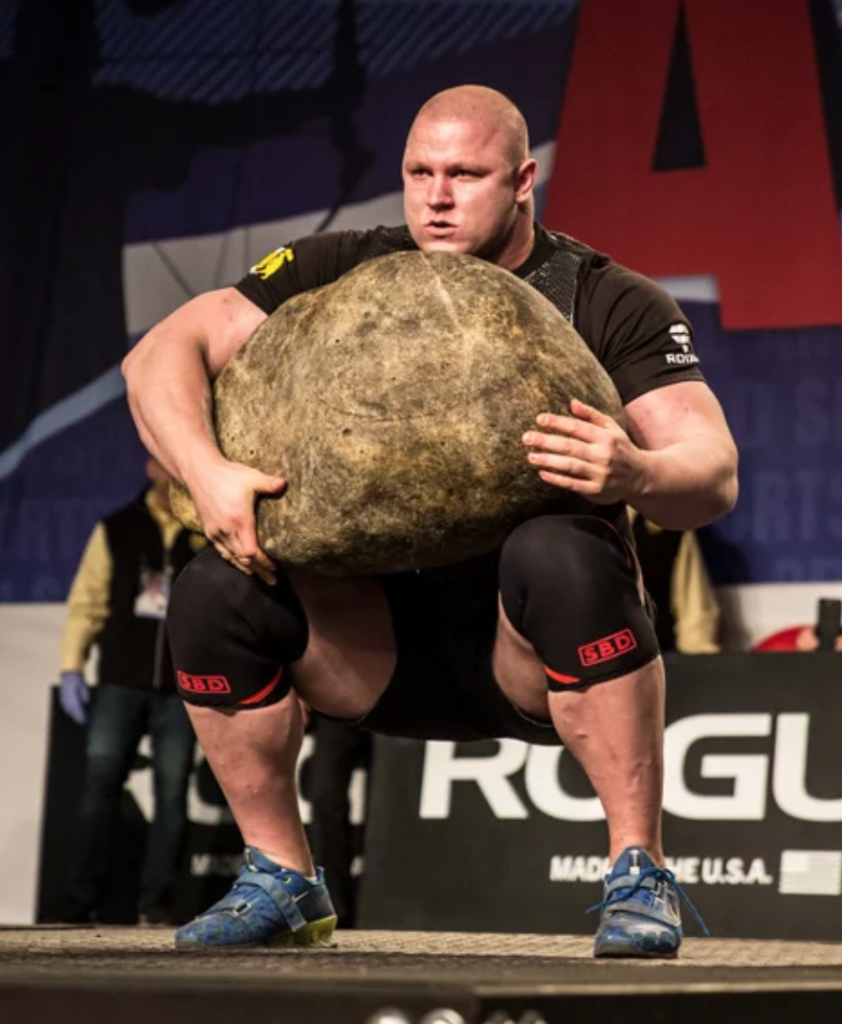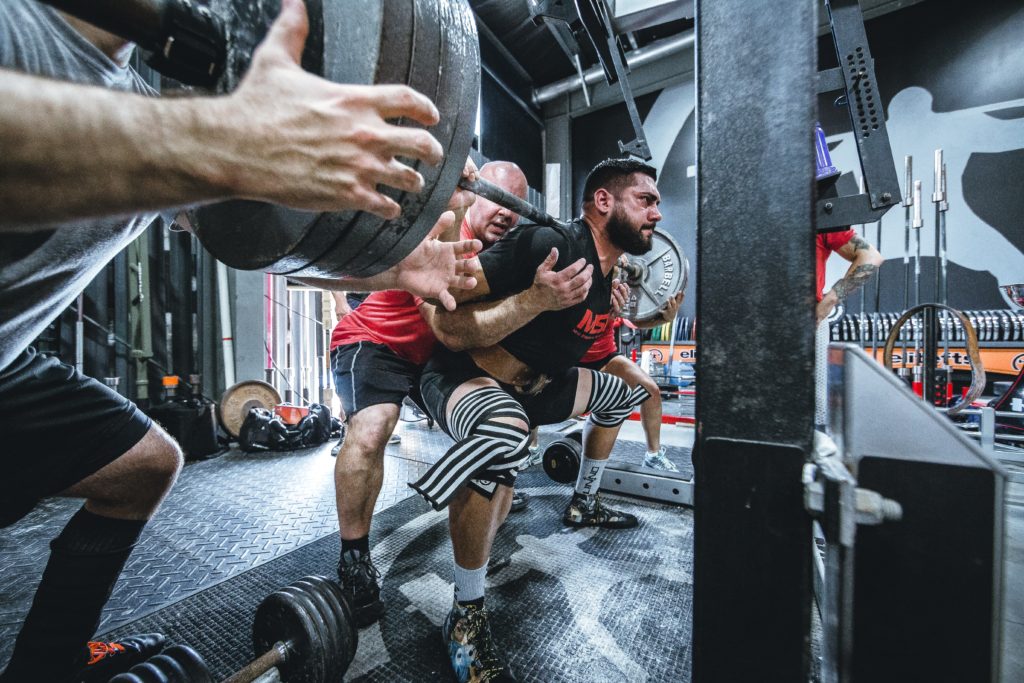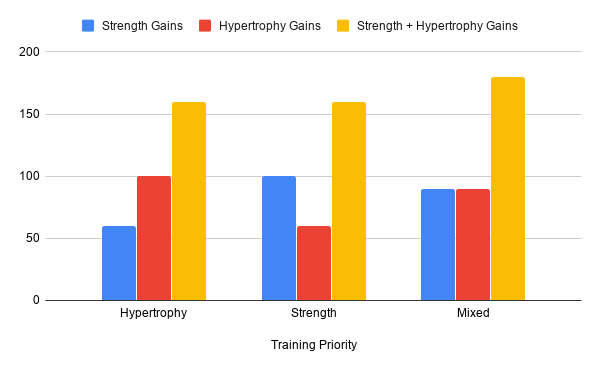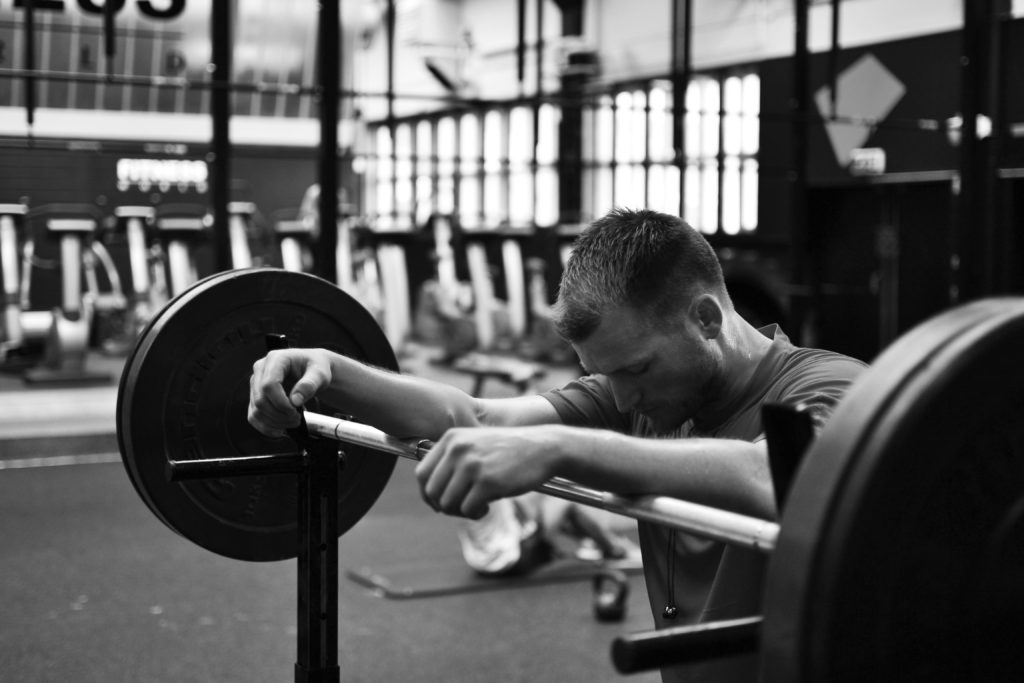This is a topic that I’m particularly excited to write about. When I started lifting my goal was always strength. I wanted to be as generally strong as possible, not while avoiding muscle but by allowing it to come with the strength.
Somewhere along the way I realised that training just for strength wasn’t gonna cut it. I couldn’t get much stronger at my current level of muscle mass, I’d have to build more muscle. I was also at the stage where training purely for strength would yield very slow gains in muscle mass.
I never liked the idea of phases dedicated purely to strength and purely to hypertrophy. Training purely for hypertrophy just wasn’t an enjoyable training style for me.
During the start of the coronavirus lockdown I only had access to lighter weights so I decided to do a dedicated hypertrophy block. There was no regard for strength in this phase and I didn’t enjoy it much.
You can have dedicated hypertrophy phases where your lower rep strength doesn’t improve much but you are building muscle. Or you could have phases where you’re getting stronger in lower rep ranges but not building much muscle.
I think it’s more enjoyable to see your lower rep strength increase while also getting more muscular. Many of my clients feel the same way,

Strong and jacked was always the goal
Maximise Both
Can you get 100% of the maximum hypertrophy possible while also getting 100% of the maximum strength possible, in short no. There’s a reason the top bodybuilders are more jacked than the top powerlifters. It’s not just body fat percentage differences.
There’s a reason powerlifters are stronger than bodybuilders (when it comes to 1RMs). Maximising the amount of muscle on your frame is different to having a lot of muscle while trying to be as strong as possible.
This is especially important the more advanced you become. For a completely untrained person there is very little difference between training for maximal strength and maximal hypertrophy. The more advanced you get the more this diverges.
There’s always a tradeoff for being the best at something. This doesn’t just apply to lifting. Decathletes aren’t world record holders in any individual event.
You only have limited resources, the specific training required to be the best at one thing takes a massive amount of time, energy and recovery resources. This means that unless the other thing you’re trying to be the best at is very similar there won’t be enough carryover to be near your potential at both.
100m and 200m sprint is a good example, they’re pretty similar so Usain Bolt could become a world record holder in both. However this was also only possible due to how much of a genetic freak he was. If he had only focused on one of them he would have still have been better at that one than when he was training both of them.
You can be world class at one thing and good at many others. You won’t be world class in several things due to the nature of what it takes to be world class.
Diminishing Returns
It’s better to think of strength and hypertrophy as a spectrum, if you maximise strength you can’t maximise hypertrophy and vice versa. Where in this spectrum your training puts you will determine how strong you are relative to your size.
As stated above you won’t be able to get as strong and muscular as possible at the same time, but you can be pretty close to both. This is a difference that won’t matter much unless you’re trying to compete against others at an elite level.
This is due to diminishing returns. you’ve probably heard of the pareto principle. If not it means that roughly 80% of the results come from putting in 20% of the effort. It doesn’t necessarily apply in all cases with those specific percentages but the principle stands well. There’s definitely diminishing returns. When you get past a low baseline each unit of effort leads to smaller and smaller increases in results.
Putting numbers to this if 50 units of effort gets you 100 units of results.
100 units of effort may only get you 125 units of results. So a 100% increase in effort only led to a 25% increase in results. Don’t get attached to the specific numbers , the principle is what’s worth noting.
How does this apply to combining both? Lets say you have 100 units of effort to give. If you purely prioritise one this may give you 100 units of results in that one and 60 in the other (as there is carryover between both) leading to 160 total units.
If you give 50 units of effort to both this may give you 90 units of results in both (carryover) leading to 180 total units of results.
Trying to balance both would give slightly worse results to either one individually, but better results overall. This is what a lot of lifters who don’t compete would like (including me).
It doesn’t even have to be 50-50. If you care about one more it’s useful to know how to combine both.
THIS IS ALL RELATIVE TO YOUR GENETICS. You may try to get as jacked as possible and put everything into it. Maximise the effectiveness of your training, diet, sleep, stress management etc over a ten year period. Genetic freaks exist and can put in less effort for half the time and get better results.
This is an unfortunate reality but largely irrelevant unless you’re competing in something. All you can focus on is getting the best out of yourself, if you’ve done that there’s nothing more you could have done so why worry?
Differences Between Strength and Hypertrophy Training
This is a good video on the differences between both, I’m a fan of RP’s work. I remember listening to this 2-3 months ago. There’s going to be similarities between what I’ve wrote here and what’s covered in the video.
There’s not much new information coming out in the fitness industry, most things have been said before. Often “new information” is just old information put into someone else’s words.
However the section at the end of this article explains in detail how to design training for strength and hypertrophy at the same time. I haven’t seen much on this before so it’ll be very useful to you if that’s something you’re interested in.
Exercise Selection Differences
Exercise selection varies depending on whether you’re training primarily for strength or size. When you’re training for strength you HAVE to do specific exercises.
Whether they’re exercises necessary for the sport you compete in. Such as the straight bar back squat, flat barbell bench press and conventional/sumo deadlift in powerlifting. Or just lifts that are a good benchmark of general strength capabilities even if they are not part of a sport you compete in. These may include weighted pull ups, weighted dips and front squats.
These lifts may not be the best for your anthropometry. They may easily irritate connective tissue and not stimulate the muscle well for the amount of fatigue they cause.
Because these lifts are used as benchmarks, to get the most out of them you will have to train them. This allows you to get the skill of the lift down to see where your actual strength lies. You may have to incorporate certain lifts that aren’t an efficient use of your time/recovery resources.
For hypertrophy there are no MANDATORY lifts. There are at least several different exercise variations and often many movement patterns that can be used to stimulate every part of each muscle. You can select exercises that seem to give you the most stimulus for the least fatigue so you can stimulate as much as possible while limiting fatigue build up.
Hypertrophy focused programs will usually include more machine based and isolation single joint lifts that use less muscle groups.

More of a focus in hypertrophy training than in strength training.
Strength focused programs will usually include more free weight/bodyweight exercises and multi joint compound movements that allow for more free movement, unlike machines.
Hybrid strength and hypertrophy programs will be somewhere in between depending on which you are prioritising.
RPE Differences
For a much more in depth article on general RPE usage check this out. As you get more advanced sets need to be taken to a relatively high RPE to be effective for muscle growth. Sets below RPE 6/6.5 or so aren’t very effective for stimulating hypertrophy.
Not that they’re ineffective. They’re just not a very efficient. Your time and energy would be better spent at a slightly higher RPE if your goal is just hypertrophy.
There is a minimum intensity (%1RM) to stimulate noticeable strength gains but it’s not that high. 75% is usually considered the lower bound, 80% is definitely heavy enough to stimulate strength well.
You could do several singles at 80%, get a good strength stimulus and still have the hardest single still be far below RPE 6. This would be a good way to stimulate strength without stimulating much hypertrophy.
However it’s very rare for someone to want to maximise strength while seeking absolutely 0 hypertrophy. This rarely occurs unless someone competes in a strength sport and has maxed out their weight class. Most people want a combination of strength and muscle mass.
Including some lower RPE strength work (to maximise technical proficiency under heavy loads and train the nervous system) and also some higher RPE hypertrophy work is a good way to accomplish both.
The ratio of which can be determined by how important each aspect is to you.
Training Frequency Differences
There are 2 different types of training frequency to consider, frequency of training each muscle group and how many days you train per week.
Hypertrophy training is more suited to a higher number of training days per week. It’s not uncommon for bodybuilders to train 6 days a week. Sometimes this includes 2 sessions per day.
It’s very rare for powerlifters to train 6 days per week, 5 is usually the highest you’ll see. Strength training is a lot more neurologically taxing due to the heavier loads lifted. Even when the volume used isn’t very high it’s not possible for most people to get amped up to lift very heavy more than 5 days a week.

I highly doubt he trains hard 6 days a week
Your joint and connective tissue integrity is another variable that has to be considered. Maximal strength training requires you to practice specific lifts, this practice also needs to be heavy. This means you need to repeat the same movement patterns relatively frequently with heavy loads. This makes it pretty easy to irritate connective tissue if you’re not careful with the rest of your programming. Bodybuilding training can use a wider variety of exercises at lighter loads which is more joint friendly.
Training frequency per muscle group is quite variable for both. Especially if we consider technically focused sessions, these are often included in strength programs to improve technical efficiency.
When discussing overloading sessions for both you can train more frequently for hypertrophy than for strength. This is because for hypertrophy training the muscle just needs to be at least close to fully recovered to overload again.
For strength all of the muscles, connective tissue and nervous system need to be close to fully recovered. The muscular system recovers the fastest out of these. Overloading strength sessions can’t take place as frequently as overloading hypertrophy sessions.
You have to maximise proficiency with a single lift when it comes to strength, this isn’t true to the same extent for hypertrophy. This means you can utilise a larger degree of exercise variation for hypertrophy which also allows you to train more frequently.
A good way to combine both each week is to have a strength session for each lift and 1 or more hypertrophy focused sessions. These should be spread out so that you’re as close to fully recovered as possible for the strength session. You can be slightly fatigued going into the hypertrophy sessions and still get a good hypertrophy stimulus.
Progression Differences
Progression for strength and for hypertrophy is similar but not exactly the same. You’ll want to increase performance over time for both (progressive overload) but this will manifest in slightly different ways for each.
For strength increasing load is better than increasing reps. It’s definitely better than increasing sets (volume) which might actually be counterproductive.
For hypertrophy increasing load and reps are both viable tools as long as the reps don’t drop too low (below 5ish). Increasing sets (volume) throughout a mesocycle is debatable.
I find a good compromise to be keeping sets for main compounds static and increasing myo rep clusters on isolation lifts. This allows slight increases in volume without adding noticeable fatigue from week to week which would impair strength.
The best way to combine both is to have a strength based day and hypertrophy based day for each movement pattern in each training week (microcycle).
On the strength based day we prioritise load increases as long as reps don’t drop too low.
On the hypertrophy based day we can try to increase load (as long as reps don’t drop too low). We can also try to increase reps with the same load.
Myo rep clusters on isolation movements can be slightly increased every week as long as the strength based days aren’t affected. If not they can remain constant, or just be increased in places where there’s enough recovery time after to not affect the strength work.
Loading and Rep Range Differences
Hypertrophy is pretty similar when taken to failure in all rep ranges across the 5-30 rep range. This doesn’t mean that sets under 5 reps don’t stimulate hypertrophy, they absolutely do. Just that as the reps get lower below 5 the sets become less stimulative on a per set basis.

Squat singles aren’t the best for hypertrophy
Trying to get compound exercise volume from purely sets of 5 and below would be great for strength but poor for hypertrophy. On a pure set for set basis they would be less stimulative. You’d also be able to do less sets as you can’t handle as much heavy volume as moderate volume.
When lifting very heavy there’s also the risk of altering your technique slightly to be able to move more load. The target muscle would be stimulated even less.
Strength isn’t technically tied to a rep range. It’s purely based on how heavy you’re lifting relative to your one rep max (1RM). However this is manifested in the rep ranges that you use. The lower the reps the heavier you can lift. Your strength base will be built most effectively with sets of around 6 reps and below, however sets of 7-10 are still effective for strength.
We can combine both of these by having both a strength and hypertrophy session for each muscle group/movement pattern throughout the week.
The strength session can be in the 4-7 rep range (mainly the lower end), which is very good for strength and is decent enough for hypertrophy. The hypertrophy sessions can be in the 7-10 rep range which all very good for hypertrophy and decent enough for strength.
Volume Differences
From the research available it’s generally agreed upon that we want to train with as much volume as we can recover from to maximise hypertrophy. This doesn’t necessarily mean we NEED to increase volume throughout a mesocycle.
Higher volume training contributes massively to fatigue levels. So we can’t have the volume too high otherwise our top end strength will be limited by fatigue levels. We won’t effectively be able to train for strength.
This seems like a conundrum, how do we reconcile these two seemingly contradictory conditions?
Diminishing returns, which we discussed at the start. If the maximal amount of hypertrophy occurs at 100% volume, you may get 85% hypertrophy at 65% volume.
This 65% volume will lead to noticeably less fatigue. If it is distributed intelligently over the week this will allow you to get a significant majority of the hypertrophy available. It will also minimally impact your top end strength work. This still allows you to drive your lower rep range strength up due to lower fatigue levels.
Designing Hybrid Strength and Hypertrophy Mesocycles
I recently published an article on the negatives of training with high volumes. At the end of that article I briefly gave some main considerations that you should abide by when creating hybrid strength and hypertrophy mesocycles. I’ll break it down in more detail here so you know how to structure your own hybrid strength and hypertrophy training.
Considerations
These are the considerations I posted in my other article linked above.
- Volume should be moderate.
- The week will be asymmetrical in terms of stress.
- The heavy strength days should be at the very start of the week.
- The middle/early end of the week should be more volume focused.
- The end of the week should be easy to recover from so you’re pretty fresh for the heavy days (whether this be from easier workouts or more rest days).
- The volume (set count) in each week should be relatively constant. The exception being the end of the final week of the block. You can increase volume here since there’s a deload coming up.
Volume
Volume can’t be too high or too low.Volumes that are too high come with significant amounts of fatigue that will affect your top end strength. Heavier strength based volume (80-85%) also tends to be more difficult to recover from than moderate volume due to the sheer loads being used.
If the volume is too low you simply won’t have enough volume to stimulate hypertrophy at a reasonable rate if you’re fairly advanced.
Recently there’s been a lot of debate on whether increasing volume throughout a training mesocycle is optimal for hypertrophy. I’ve tried both keeping volume (in terms of hard sets) constant and increasing them slowly throughout a mesocycle.
It’s hard to say if increasing volume through a mesocycle is better for hypertrophy. I’ve found success increasing it very slowly. It’s easy to increase too fast and run yourself into the ground. I don’t think your body adapts to a given volume level quickly enough to justify quicker increases in volume.
An increase from say 10 sets of chest to 16 throughout a training block is probably overkill and can even hold back your long term progress.
Rapid volume progression definitely isn’t the way to go with hybrid training. The fatigue from rapid set increases will absolutely hinder how much you can lift on your strength based days.
I find increasing myo rep clusters throughout a mesocycle for small easy to recover isolation movements to be the best way to increase volume over a mesocycle. The fatigue increase from this is minimal. It may take you from 10 sets to 11/12 throughout a mesocycle using only movements that are easy to recover from.
This can also be done on hybrid programs as the fatigue is minimal. The clusters could even be increased at an even slower rate such as every other week.
In the final week of the meso, even on main compounds volume can be increased slightly in the second half of the week. This is because the strength based work has already been completed, and there’s a deload coming up to drop any extra fatigue generated.
Asymmetrical Stress
You need to be relatively fresh with minimal fatigue on your strength based days. We need a certain amount of volume to drive hypertrophy, but it needs to be placed in a way that it doesn’t disrupt your heavy days too much.
The goal should be increasing peeformance on all days from week to week. At the very least it should be increasing on your strength based days if it’s holding constant (in the short term) on your more volume focused days.
Lets take an example of an upper/lower split to make things simple.
This could be accomplished by training heavy upper and lower on days 1 and 2 respectively. Moderate upper lower on days 4 and 5 respectively. Having days 3,6 and 7 as rest days.
Keeping volume (in terms of hard sets) the same on both days would give you an extra rest day for each muscle group before the strength days. This is fine. You can still get enough volume and and intensity on the moderate days to stimulate hypertrophy.
With higher frequencies this can still be done, you just have to think a bit more. For example if you were training a muscle 3x a week. Such as training the pressing muscles on days 1,3 and 5, you may divide the sets roughly equally but bias days 1 and 5 a bit.
- 7 sets on days 1 and 5, 6 sets on day 3.
- Day 1 would be the strength based day, days 3 and 5 would be more volume focused.
- Day 3 would include movements that favour shorter muscle lengths, so that there’s minimal/no soreness/muscle damage for day 5.
- Day 5 may have movements that stress longer muscle lengths which leads to a bit more stimulation and soreness. Due to the 50% extra recovery time you can still recover in time for next week’s day 1.
This can be done with even higher frequencies, you just need to keep the general principles here in mind.
Mesocycle Design
I’m going to use the example above of a 4x a week upper lower split and show how I’d design the upper body days throughout a mesocycle. I don’t want to make this article obscenely long so I’ll just show the upper body progression. You can 100% get the concept from what I’m going to show you without the lower body aspects.
Don’t get too attached to the specific exercise variations, sets and weights used. This is a super generic training block. The idea is to just show how things progress throughout the course of a mesocycle.




The main points to take away are that:
- The weights and RPE (proximity to failure) increase slightly every week.
- Volume (hard sets) stays constant for the main compounds (no set change from week to week barring deload).
- Volume increases very slowly for less fatiguing isolations in the form of myo rep clusters. This isn’t mandatory, they can be kept constant as well.
- There is slight undulation throughout the week in terms of loads used.
- There’s enough variation in loading to gain the benefits of daily undulating periodisation (DUP).
- Average rep range for compounds is around 7 reps per set, and is higher for isolations in the form of myo reps.
- On the heavier days barring the deload, most of the loads used in the compounds will be in the 77.5-87.5% range. This is great for strength.
- The reps are also high enough to be effective per set for hypertrophy (there aren’t many sets below 5 reps).
- The isolations in the form of myo reps are light enough to ensure you’re still targeting the correct muscles (would be hard to do lateral raises and target the side delts with sets of 6).
- On the strength based days the myos are just heavy enough to get a small strength stimulus (thought that’s not the main purpose of isolation lifts). They’re still in an appropriate rep range for hypertrophy.
- On the strength days when doing multiple sets not every sets has to be in the RPE range. Early sets can be slightly below the target RPE to accumulate less fatigue. The final set should always be in the range to ensure you’re not too far from failure.
Conclusion
As long as you take into consideration the information in this article you can program for strength and hypertrophy at the same time. You won’t 100% optimise either but will get the best of both worlds, which I believe is what plenty of lifters actually want. I find it to be a more enjoyable way to train as well.
Interested in coaching to take your progress to the next level?


